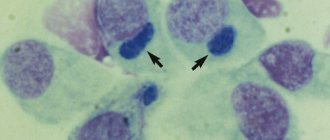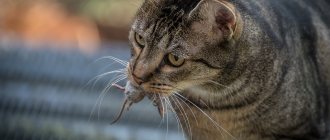Asthma in cats manifests itself in the same way as in humans: the animal coughs, chokes, suffers from suffocation and shortness of breath. In the initial stages of the disease, the pet can quickly come to its senses, which can confuse the owner and delay diagnosis and treatment aimed at stopping the attacks. In order not to confuse the manifestations of the disease with the fact that the pet is choking on food or vomiting a hairball, the owner must know the main symptoms of the disease and understand what factors lead to the development of feline asthma. Today we will tell you what signs indicate illness, what to do if your furry friend gets bronchial asthma, and we will also figure out whether asthma can be treated in cats.
Asthma in cats: how to diagnose and treat?
Bronchial asthma in cats: general information
As a rule, symptoms of an asthma attack in felines are caused by inhalation of an allergic substance that causes inflammation in the lungs. When an animal breathes in an allergen, the body interprets it as a danger to the immune system and launches a reaction against the aggressive antigen. As a result of this reaction, the airways narrow and mucus accumulates in them.
Allergens and their sources for cats and kittens
Accordingly, during an attack, the animal may cough, wheeze, and breathe heavily. This is due to narrowing and swelling of the walls of the respiratory tract, therefore, with a lack of air. In addition to acute attacks, there are also chronic symptoms. The owner may notice that the pet's breathing has changed - instead of silent it has become gurgling or whistling. Such “sound effects” are a reason to be wary.
Normally, a cat breathes silently - even at close range it is difficult to hear the sound of breathing
Similar to how asthma occurs in humans, in cats this disease is chronic. In addition, it is almost impossible to get rid of the disease forever. But with competent and timely diagnosis and correctly prescribed therapy, it is possible to achieve stable remission in the animal, and therefore improve the quality of life.
The owner must understand that the mustachioed pet will be prescribed the appropriate medications for life. However, there is nothing wrong with this - treatment for feline asthma does not cause the animal pain, and both the animal and its owner quickly get used to frequent manipulations. Thus, the therapy will not burden the person, cause serious discomfort to the pet and take a lot of time.
An animal diagnosed with asthma should be treated with care and care.
Causes of Asthma in Felines
Modern veterinary medicine is unable to give a clear answer to the question: “What is considered the root cause of asthma in cats?” But, despite the insufficient knowledge of the etiology of this feline disease, it is precisely established that the key factor that provokes the disease is an allergic reaction.
Veterinarians name a number of reasons that can provoke an asthmatic attack in cats. These include:
- Frequent stressful situations.
- Heredity (a parent couple where at least one animal suffers from asthma has a high probability of giving birth to kittens with a predisposition to the disease).
- Breed disposition (it is believed that Siamese and Himalayan cats, as well as their crosses, are more susceptible to the disease than others).
- Viral and infectious diseases left without appropriate treatment.
- Non-infectious diseases that affect the pet's respiratory system.
- Allergens that constantly affect the animal (cigarette smoke, dust, chemical fumes, pollen, parasites living on the skin).
From the very first days, the kitten in the house must be protected from exposure to harmful substances (tobacco, chemicals)
At the same time, the age factor is not decisive - asthma can develop in both a kitten and an elderly animal. But the seasonality of the disease does occur. In felines, as in humans, seizures tend to become more frequent at certain times of the year (spring) and in certain areas or weather conditions.
Treatment of the disease
The basis of treatment for an asthmatic cat is drug therapy. Often it must be lifelong. The following groups of drugs are mainly prescribed:
- Hormonal agents - glucocorticosteroids (Prednisolone). They stop the inflammatory process in the bronchi and are the basis of symptomatic therapy. Their long-term use is dangerous due to the occurrence of severe side effects from the liver, kidneys and blood vessels.
- Drugs that dilate the bronchi (mainly based on salbutamol) can quite quickly stop attacks. Available in aerosol form and administered using an inhaler.
- Antibiotics are used only if a bacterial respiratory tract infection also needs to be treated.
- Vitamins are designed to support the body's defenses.
Features of hormone therapy
Hormonal drugs can be introduced into the body in one form or another. Which of them is most appropriate in a particular situation must be decided by the attending physician.
- Drugs in tablet form are prescribed to obtain a quick therapeutic effect. They create a constant therapeutic level in the body, which ensures the absence of attacks throughout the entire treatment period.
- Injectable drugs are easily administered into the animal's body. They accumulate quickly and, accordingly, quickly provide a therapeutic effect. But at the same time, they also have disadvantages in the form of the possibility of developing side effects.
- Aerosols allow the drug to reach the bronchi directly. Therefore, they have a local effect and do not affect other organs and systems. Drugs administered by inhalation accumulate much more slowly and begin their anti-asthmatic effect only after 3-4 weeks.
Treatment of asthma in cats, to accelerate the effect, begins by combining tablet drugs with inhalation drugs.
Inhaler use
To administer drugs in the form of aerosols, you need an inhaler or spacer - a device with which the drug is sprayed into the airways. They consist of a special chamber into which the medicine is sprayed, and a mask attached to it. Having brought the mask to the cat's face, you need to hold it for a while so that the animal can take a breath several times.
An oxygen mask may also be required to relieve severe attacks.
Asthma in cats: stages of development
Bronchial asthma occurs and manifests itself differently in animals, and based on the intensity of the attacks and the threat to the life and health of the pet, three stages of the development of the disease are distinguished.
Table. Stages of feline asthma
| Soft stage | Middle stage | Heavy stage |
| Seizures occur infrequently (perhaps once a month), last less than a minute, and the animal quickly recovers on its own. At this stage, the owner may not even suspect that the pet is suffering from bronchial asthma, especially if attacks occur while family members are away from home | Asthmatic attacks are still quite rare, but they are accompanied by more severe symptoms. This condition is dangerous to the health of the animal. | At this stage, seizures threaten the animal's life. If you do not pay attention to the symptoms and do not take therapeutic measures, the cat may suffocate and die at the highest point of the attack. |
At the first asthmatic attacks, the animal should be shown to a veterinarian
The task of a responsible owner is to prevent feline asthma from progressing to a severe stage that is life-threatening to the animal. Therefore, at the first symptoms, the cat should be taken to the veterinarian, since it can be not only about treating the pet, but also saving its life.
Symptoms of feline asthma
Signs of asthma are differentiated from other respiratory tract ailments, viral infections, heart failure, and even foreign bodies entering the animal’s respiratory organs. However, the owner must be able to distinguish asthma both from another disease and from an episodic danger or even a physiological process. Thus, an attack of bronchial asthma in a cat can be confused with regurgitation of fur or a moment when the animal chokes on food or another object. Below we will tell you what symptoms distinguish the disease in question.
It is important to understand in time why the animal feels bad
Feline asthma attacks have characteristics that you need to pay attention to. Firstly, the disease manifests itself with some frequency and the owners note that the animal suddenly “gets worse” against the background of excellent health. Secondly, asthmatic attacks are insidious because in the intervals between them the cat continues to feel good: eats, plays, looks cheerful.
During an asthma attack, your cat appears to be choking and suffocating.
During the attack itself, as well as before and after it, people around the animal can observe the following:
- The cat looks worried, rushes around the room, cannot find a place for itself.
- When an attack occurs, the animal takes a characteristic pose - the paws are bent, the head is lowered, the cat breathes with its mouth open.
- Choking occurs unexpectedly for a cat, so it can experience an attack in any place where it finds it.
- The cat coughs violently, breathing comes out with wheezing and whistling.
- After an attack, the cat looks tired, lethargic, refuses food and communication with the owner.
Video - Cat cough
How to help a cat with an asthmatic attack?
A person experiencing an attack of bronchial asthma in their pet for the first time may be frightened. The first rule of first aid for an animal is to stop panicking. It is necessary to ensure that the cat does not injure itself, and also to eliminate any possible danger to it. At the time of an attack, the pet is defenseless, so it can fall from a height, another animal can attack it, or a child can suddenly grab it.
The owner himself also does not need to grab the animal while the attack lasts. It is better to stay near the cat and observe the development of the situation. If the coughing and wheezing quickly stop, you need to carefully place the animal in a carrier or any box of a suitable size and take it to the doctor.
Wait until the attack stops and go to the doctor
It is important to understand under what circumstances the animal began to cough and choke. If the symptoms appeared out of the blue, that is, the cat was lying in the owner’s field of vision, and then began to thrash about and wheeze, it makes sense to suspect a disease of the respiratory system. If the attack began while the animal was eating food or while playing with any object, it is advisable to examine the cat’s oral cavity for a foreign body.
If you suspect that the cat is choking, secure it by placing it on its back, open its mouth and shine a flashlight into the depths of the esophagus. You can remove the foreign object with your fingers or tweezers; if your cat has swallowed something sharp, go to the veterinarian for help.
It is worth understanding that an asthmatic attack differs from an attack of suffocation due to a “foreign object”: in the first situation, the cat behaves statically, freezing in a characteristic position, in the second, it will roll on the floor, helping itself with its paws and in every possible way trying to free itself from the object that has fallen into the throat.
Even with a mild asthmatic attack, the animal should be seen by a doctor.
If the cat goes into a prolonged severe attack (the root cause of suffocation is no longer important here - this condition is fatal in any case), you need to act quickly and decisively. If you have a car, you must immediately take the animal to the veterinary clinic, calling the doctors by phone and informing them of your arrival. If it is not possible to take your pet, you need to consult a veterinarian by phone, ideally if you can call a specialist to your home.
Unfortunately, it is impossible to stop an attack without the means at hand and the necessary medications, and if it happens for the first time and immediately has a high degree of severity, then, of course, the necessary drugs are not at hand. However, asthma rarely develops instantly and immediately affects the pet with severe symptoms. But in order not to lead to a dangerous situation, you need to react to the slightest manifestations.
It is not advisable to treat feline asthma with improvised means.
Clinical manifestations
Typical symptoms of asthma in cats are:
- Suddenly the breath stops and there is a lack of air.
- A hysterical cough appears due to a sharp contraction of the bronchial muscles.
- During an attack, a cat takes one position - its paws are bent, its neck is strongly stretched forward, its head is lowered to the floor. In appearance, this position resembles an animal’s attempts to regurgitate its fur.
- Lethargy and apathy, refusal to eat, drowsiness, reluctance to move.
- The mucous membranes become bluish due to acute lack of air.
In severe clinical cases, the furry pet lies on its stomach on the floor with its mouth slightly open, breathing heavily and intermittently.
Degrees of the disease
The intensity of the symptoms of the disease and the frequency of attacks depend on the degree of development of asthma:
- Easy . Attacks recur no more than once every 1-2 months. In some cats, the mild stage of the disease may be accompanied by 1-2 attacks per year. There are no signs, the animal feels well, there are no complications or risks of their occurrence.
- Average . Attacks of coughing and shortness of breath occur every week. During intense exercise: during running, jumping, shortness of breath occurs, the pulse quickens, and the cat becomes emotionally excited.
- Strong . Asthmatic attacks recur every day. In addition to coughing, the pet has severe shortness of breath, wheezing and whistling can be heard in its breathing. Motor activity decreases. After an attack, the cat sits upright, with its head held high, trying to inhale as much air as possible.
- Heavy stage . It manifests itself in intense attacks that occur several times a day. The cough is accompanied by a strong acceleration of the pulse, a decrease in body temperature, and a lack of response to external stimuli. During an attack of painful coughing, the animal arches its back, breathing is sharp and gusty. The pet's behavior changes. He may show complete apathy or, conversely, show excessive irritability and aggression.
Many owners cannot independently distinguish asthma from other diseases accompanied by cough. When detecting the first attack in an animal, even the mildest and short-term one, you must immediately seek veterinary help.
First aid
The owner of a cat whose asthma has been diagnosed for a long time knows very well how to help the animal during an attack in order to alleviate the condition and prevent the development of serious complications. Beginners in this regard may get confused and miss precious minutes. Veterinarians and felinologists recommend acting calmly and step-by-step during an asthmatic attack:
- It is strictly forbidden to panic. The cat acutely senses the mood of its owner and will react accordingly to screams, hysteria and fear. Therefore, it is important to calm down yourself and do the same with your pet. Approach him, talk, call him by name, pet him.
- If possible, you need to give your pet a drink of water. This will help remove phlegm from the bronchi.
- Give a plant-based sedative. If there is a special spray with herbal extracts or cat pheromones, it should be sprayed in front of the animal, for example, on its bedding.
In the absence of positive dynamics, if the attack does not end and the pet’s condition worsens, it is necessary to take it to a veterinary clinic as quickly as possible.
Indications for contacting a veterinarian as soon as possible: fainting, difficulty breathing, or complete stoppage.
Diagnosis of asthma in cats
If the animal has recovered from the attack on its own, it is better to schedule a visit to the doctor on the same day. Tell the specialist in detail how the attack occurred (duration, intensity, behavior of the animal before and after). After listening to the complaints, the veterinarian will prescribe a series of studies, which include:
- Analysis of a blood sample, including identifying the presence of allergens in the body.
- Chest X-ray, which helps not only to diagnose asthma (enlargement and thickening of the walls of the bronchi, diaphragmatic stretching), but also to exclude bronchitis, formations in the lungs and other ailments of the respiratory system.
- Tests for diseases of viral and infectious etiology.
A blood test in cats is the most accurate laboratory method for studying the state of general health and specific organs. How is the procedure performed, what indicators are considered normal? Read more in our article.
The veterinarian will also examine and feel the animal and listen to the cat’s lungs with a stethoscope. In some cases, individual tests and examinations will be prescribed - this depends on the overall picture of the animal’s condition.
The diagnosis is not made without certain diagnostic tests
Diagnosis of the disease
If you have breathing problems or a cough, without waiting for attacks or other complications, you should contact a veterinary clinic to identify the source of feline asthma. Based on research data and the clinical picture, the veterinarian will be able to distinguish feline asthma from other diseases and pathologies of the respiratory system, which may occur with similar symptoms. Diagnosis is based on a medical history, a description of the signs of asthma in a cat, examination and listening, additional tests and studies. Video recording of attacks will not be superfluous to visualize the state at a critical moment.
Allergens that can trigger asthma are:
- parasitic infestations;
- chronic infections;
- cat litter;
- feed;
- microscopic fungi, mold, pollen;
- dust, dust mites;
- smoke and other negative environmental conditions;
- household chemicals, plastic with a strong odor, paints;
- perfumery.
In modern veterinary medicine, various methods for diagnosing the disease are used. Clinical and biochemical blood tests will help diagnose a probable inflammatory process. In asthma, an increase in the concentration of eosinophils is allowed. The results provide comprehensive information on the state of the blood and indicate deviations.
Chest X-ray is the most revealing method for diagnosing diseases of the respiratory system. With asthma in cats, characteristic changes occur - transformation of the bronchial and pulmonary patterns, which will be clearly visible on the x-ray, which will facilitate the diagnosis. The X-ray method allows you to diagnose the condition of the pet’s respiratory organs: trachea, bronchi, lung tissue, as well as the size of the heart and the condition of the pulmonary vessels.
Bronchoscopy refers to an endoscopic method for examining the respiratory tract. The examination is carried out under full anesthesia. The respiratory system is examined using an endoscope. During the examination, the veterinarian assesses the condition of the internal structure of the bronchi, trachea, and the condition of the pet’s mucous membrane. During bronchoscopy, bronchoalveolar lavage is performed - washing from the surface of the smallest bronchi, followed by laboratory analysis of the material. This method identifies infectious agents, structural disorders of the bronchi and trachea, and signs of oncological tissue changes. Lavage is the most informative in the diagnosis of chronic lung diseases and is considered an expert one, but if the study does not reveal the cause, based on the results of the data obtained, assumptions can be made that will help in the future to establish an accurate diagnosis.
How to treat bronchial asthma in cats?
Feline asthma is treated exclusively with medication; surgery is not prescribed. In each specific case, the veterinarian will prescribe his own treatment regimen, but usually asthmatic cats are treated comprehensively. The basis of therapy is the use of drugs that dilate the bronchi (produced in the form of an aerosol and used by the owner to relieve an attack), as well as hormonal drugs that treat inflammation in the respiratory tract.
If there are concomitant diseases, antibiotics and vitamin complexes may be prescribed to maintain and improve immunity and general health. If we talk about hormonal drugs, doctors prefer a combination of several of their forms to achieve a quick and lasting therapeutic effect. Let's consider what options for hormonal treatment of feline asthma exist.
Cats with asthma require comprehensive treatment
Hormonal veterinary drugs exist in three popular forms:
- pills;
- injections;
- aerosol.
At the first stage of treatment, all three forms of drugs can be used, depending on the stage of the disease and symptoms. So, the injections quickly enter the body and act quickly, so the doctor can give the first injection right away. Hormones in tablets are easier to give at home; the therapeutic effect occurs within an hour and lasts quite a long time.
There are special inhalers for asthmatic cats.
The most convenient format for hormone therapy for the owner is aerosol cans. A special inhaler with a mask is connected to the balloon, which is brought closer to the animal’s face. The cat needs to be held for a while so that it takes several (as recommended by the veterinarian) breaths of the medicine.
The aerosol has an advantage: the medicine acts locally, irrigating the bronchi themselves, without affecting other systems in the body. There is also a drawback: medications in the form of inhalations have a slow cumulative effect and the effect appears after two to three weeks. Therefore, during this period, additional hormones are prescribed - in injections or tablets.
Temporarily prescribed hormonal drugs
Treatment of asthma in a pet
Therapy for a sick cat should be based on medication. In often situations, an animal has to be treated for its entire life. Methods for treating cat asthma include the use of the following drugs :
- Glucocorticosteroids - used to relieve inflammation in the bronchi. Long-term use of hormonal drugs negatively affects the condition of the cat’s blood vessels, kidneys and liver.
- Medications for dilation of the bronchi containing salbutamol are used to quickly relieve the animal from attacks. The products are produced in the form of aerosols and are used as an inhaler for cats with asthma.
- The use of antibiotics is only appropriate when a bacterial infection develops in the respiratory tract.
- To maintain immunity, the cat is given vitamins.
Feline asthma: preventive measures
In order not to once again provoke attacks in the cat, the owner must adhere to three simple rules. The first includes hygiene in the apartment, house or other premises where the pet lives. It is necessary to do wet cleaning daily, and if possible, install an air purifier at home (this will be useful for all household members). During flowering periods, you need to open windows less often; you can hang wet gauze or other fabric near the window, which will collect pollen and dust flying from the street.
Limit the animal's access to an open window to prevent the cat from inhaling outdoor allergens.
The second point is proper and balanced nutrition for the animal, which should be hypoallergenic. Avoid allergy-causing foods in your cat's diet: dairy products, chicken, lamb, corn, wheat gluten. The diet plan should be discussed with your veterinarian. The last point is hygiene and care for the mustachioed pet itself. The animal must be washed as needed, using special hypoallergenic cosmetics, treated for parasites, and brushed regularly.
Food should be hypoallergenic
How dangerous are cat fleas for pets and humans? How to detect fleas on pets in time and get rid of them? Read in the special article.
Summarizing
It is believed that there is no effective therapeutic treatment for feline asthma that would completely stop the disease. However, this does not mean that owners should calmly watch how the animal suffers - manifestations of asthmatic attacks can be successfully eliminated.
With the help of preventive measures and a number of veterinary medications, it is possible not only to significantly reduce the number of attacks, but also to prevent the development of asthma and its transition to a more severe stage. To make life easier for a cat suffering from bronchial asthma, the best option would be to promptly contact a veterinary clinic, where specialists will examine the animal, conduct the necessary diagnostic tests and write out an individual treatment plan.











